I love to get out and see the beautiful views in San Juan County. I grew up here and I had the perfect growing up life. We lived on the east side of town. I’d get with my boy friends and we’d just take off and go hiking. We would go out to Recapture. And out on Mustang Mesa. We were all so free. Now, 70 years later, I still love and know the land that has always been so important to me.
My wife Patsy and I still like to venture out to our favorite places to do some photography. In January, February and March of 2018, we were visiting and photographing along Utah Highway 95. I’ve recently become interested in drone photography and so I was especially trying to shoot some aerial photos of the segment of the old Mormon trail that has a trail head at the turn off to Natural Bridges. Everything looked to me as it always has. We did not notice any dying junipers.
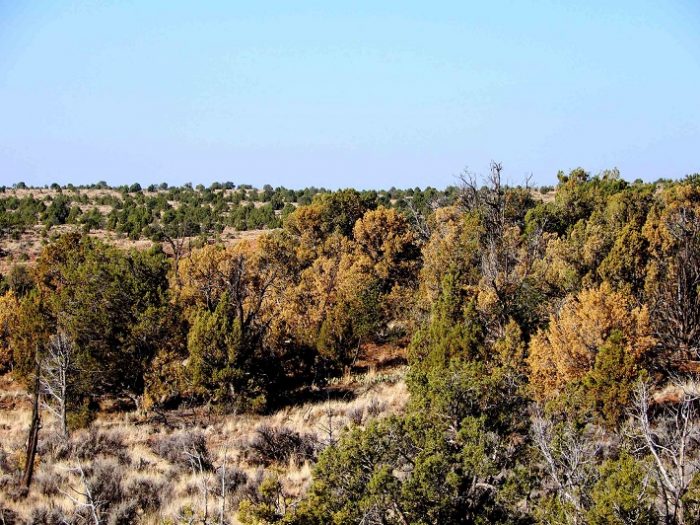
We were back again last April and then in May, returning to our old stomping grounds along Highway 95. I wanted to photograph the Black Hole of White Canyon and then the area around Salvation Knoll. Like before, the juniper forest looked healthy and vibrant. These junipers can live for hundreds of years and were the same trees I’d first seen as a boy, many decades ago. It was easy to assume that they would be there for many decades to come.
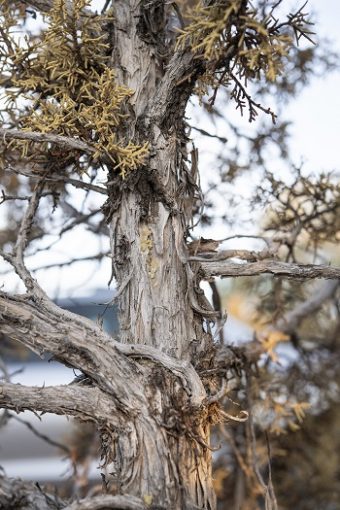
But in late May, something changed. We were on Cedar Mesa near the south end at Moki Dugway. Patsy and I probably noticed some dying junipers, and we commented to each other, but neither of us was unduly alarmed. So I did not photograph them.
On June 20th this all changed rather dramatically. We went out to photograph the fabulous views from Muley Point and this time noticed a large number of dying junipers at the south end of Cedar Mesa, around mile marker 10 on State Highway 264. This die-off shows up as a yellowing of the juniper needles. The dying/dead needles would turn yellow and make the trees stand out and easy to spot.It looked like an autumn scene of deciduous trees from a distance. But these were juniper trees.
This was very startling to us. We could easily see the big changes that had taken place since our visit just a month ago. We stopped and photographed with a land camera and a drone. The drone videos and stills showed that the die-off extended well beyond the road on both sides, especially to the east. I walked around among the junipers, amazed at the number of dying junipers. The ages of the dying junipers varied. Some, I would guess, were less than ten years old; others were probably over 200-300 years old.
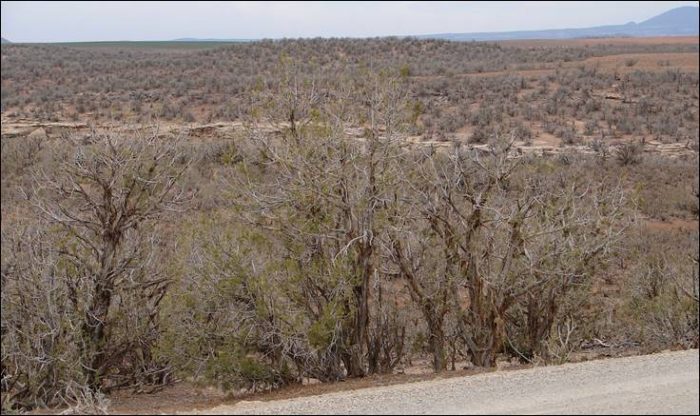
Also there were dead trees well spaced from any others and dead trees where they were clustered together. This observation suggested that drought is not the main factor. To substantiate that idea was the fact that the pinyons, which are normally more susceptible to drought, were green and healthy looking. It is worth noting here that the die-off was spotty in the sense that a large area would have many dying junipers and other adjacent areas still looked quite healthy and unaffected.
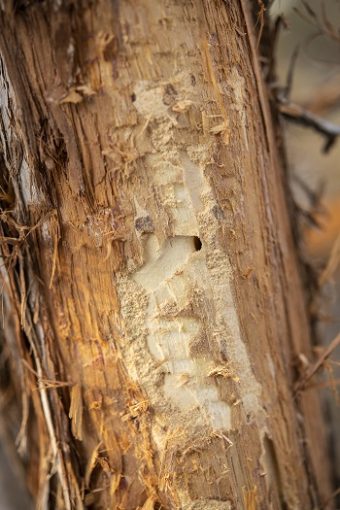
The observations on June 20 alarmed me enough that I started to drive around the county to see how widespread the die-off was. I checked out junipers directly east of Blanding, out on Mustang Mesa, on Alkali Ridge, on Murphy Point, on Black Mesa, four miles north of Blanding on US 191, and on West Water point. The die-off was every where I looked in the southern part of the county. But starting about five miles north of Blanding the die-off drops close to zero.
On July 30, the die-off had spread north, near the south end of Cedar Mesa. Now we also saw dying junipers on the north east portion of Cedar Mesa near mile marker 103 on highway 95.
Being a curious person with a scientific background I decided to examine some of the dying trees by striping the bark from the main trunk and side branches to expose the phloem. What I discovered was worrying. I could see that flat headed larvae were living on the phloem and as a result, were girdling the trees. So my first hypothesis was that a bark beetle had laid eggs on the bark, the eggs had developed into larvae, which in turn fed on the phloem.
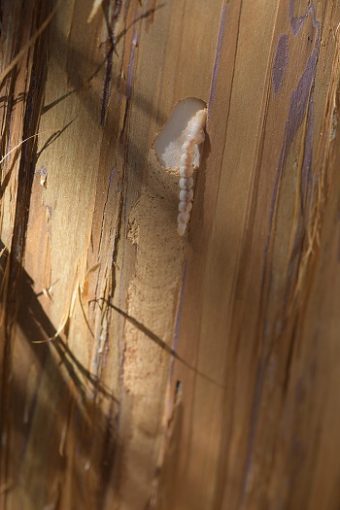
Phloem “is the living tissue that transports the soluble organic compounds made during photosynthesis and known as photosynthates, in particular the sugar sucrose, to parts of the plant where needed. This transport process is called translocation.” It is vital to any plant’s life.
Since the phloem conducts photosynthetic products to the roots from the needles, the larvae were cutting off the flow to the roots and the roots were dying. When the roots die and can no longer take up water to be conducted to the needles through the xylem, the needles and the tree dies. The paths the larvae follow as they chew away on the phloem are called galleries and are easy to spot once the bark is removed. (Since I am not an entomologist this may be an over simplification. I have posted several aerial videos on YouTube, Vimeo and Facebook showing the die-off in several locations. Some videos include live larva.)
This girdling model was tested by examining trees in 7 or 8 locations. The only exception to finding larvae in dying junipers was Black Mesa. I did not even find galleries on the them. I don’t know what to make of this.
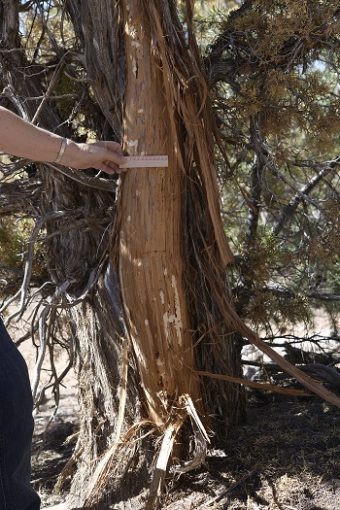
I noticed that the Flagstaff office of the BLM/Forest Service encouraged citizens to bring samples of problems to their attention.s. So we mailed them some photos of dying junipers, larvae in isopropyl alcohol and a small sample of a dead branch. We heard nothing back from them, but more on this later.
On July 16 at the suggestion of Al Schneider of Cortez, Colorado, I sent an email to Mary O’Brien asking her if she knew about the junipers dying in large numbers. Al and I have been hiking and photographing flowers together for years. He is the author of the excellent site on Colorado wild flowers which includes south eastern Utah. Less than 30 minutes later Mary sent me an email expressing interest and wrote that she would ask a couple of people about it.
I later learned that she works for Grand Canyon Trust and has contacts with people who work at federal agencies. The publicity about the dying junipers began there and has continued to grow. Articles about the dying junipers in San Juan County have been published in the San Juan Record and by Brian Maffly in the Salt Lake Tribune.
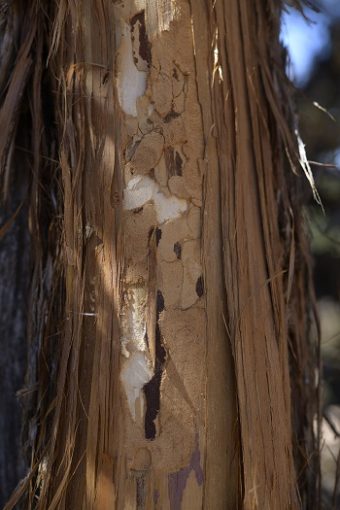
Under the leadership of Liz Hebertson PhD, a plant pathologist with the Forest Health Protection Ogden Field Office, we planned a field trip with several professional employees from the BLM, the Park Service, the Forest Service, Mike Popejoy from Grand Canyon Trust, and Brian Maffly from the Salt Lake Tribune.
We met at the Blanding city visitors center on November 28. Approximately 20 of us traveled together to our first destination, Alkali Ridge, where I offered my opinions on the die-off. I explained how I had removed a few strips of bark from several of the dying trees to discover the tree-killing larvae. To my surprise, I drew a mild rebuke from the BLM people. They complained that I did not have a permit to remove the bark, and subsequently was violating the rules.
Since the BLM has been cutting down large numbers of junipers and burning them, as part of their habitat protection and enhancement program, it had never crossed my mind that I needed a permit to strip the bark from 10-12 dead junipers. I am now in the process of obtaining a permit.
The group cut down several juniper trees on Alkali Ridge and examined them by stripping the bark. Samples were collected to take back to their labs for further examination. It was there that Liz told me that the Flagstaff office had sent my photos and larvae samples to her.
After Alkali Ridge we had a leisurely lunch at the Blanding visitors center. Each person brought their own. We then went to the north east portion of Cedar Mesa near mile post 104 or so on state highway 95. The rest of the day was spent there cutting down dead junipers, digging down to examine roots, collecting samples of larvae and looking for bark beetles.
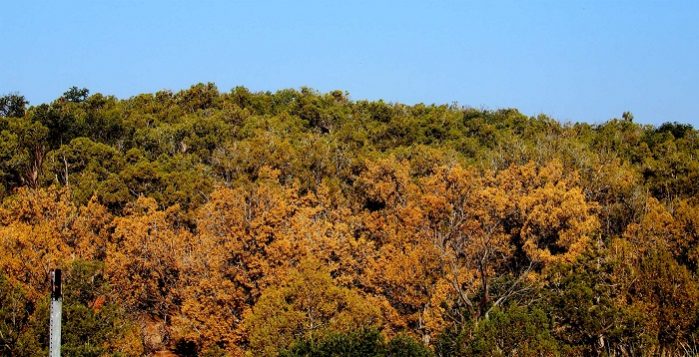
Eventually, a report about the day’s findings will be published and might even be made public. Meanwhile the effects of the spreading juniper die-off continues to change the face of Cedar Mesa and San Juan County. In my lifetime and for many years to come, the land I have called my home for more than eight decades will never look the same.
Kay Shumway is a photographer and retired professor who lives in Blanding, Utah. To learn more about Kay, please read: AN INTERVIEW WITH KAY SHUMWAY: A Life in San Juan County & beyond…with Jim Stiles
To comment, scroll to the bottom of the page.
Don’t forget about the Zephyr ads! All links are hot!


*Note: The Cartoonist screwed up. In a subconscious attempt to escape the world’s news, he changed one of our Backbone Member’s names from “Michael” to “Richard” Cohen. Sorry, Michael. We know you’re a way better guy than that infamous Michael Cohen and we beg your forgiveness.








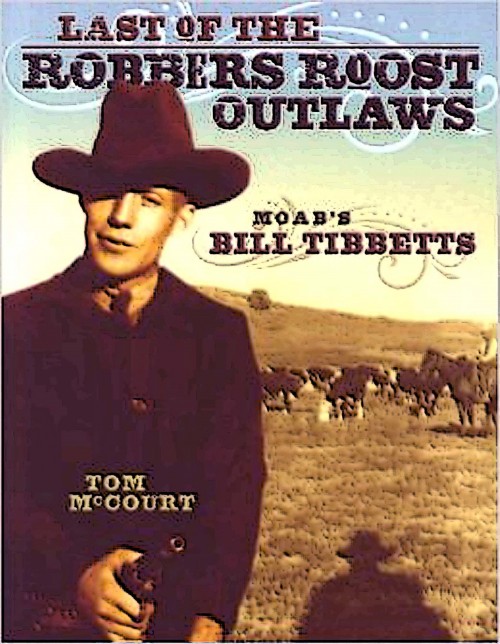

Wow, that is disconcerting. Thank you for your efforts, and insight.
Wow… that’s especially disconcerting as in the northern part of San Juan County, it’s the piñon and not the juniper that is dying of en masse. Hopefully, we’ll have some trees left alive in the middle elevations of San Juan County in a decade.
I applaud your investigation , seems we are losing trees of various species all over Utah . As an ISA Certified arborist working in the Northing part of the state I am seeing an alarming amount of tree losses due to Borers and Beetles , recently working on an outbreak of Dutch Elm Disease in Ogden Canyon . ( see Fox News Utah and Ogden standard Examiner news stories About Dutch Elm Disease . All these issues have one common thread,
Trees that are stressed most often from drought.